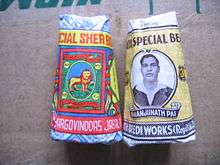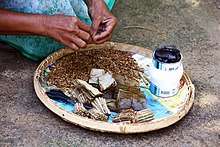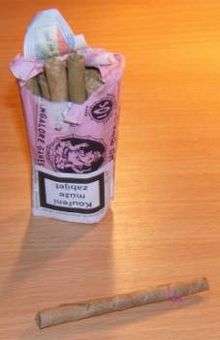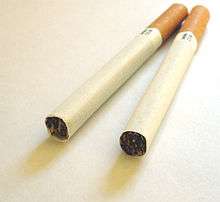Beedi
A beedi (also spelled bidi[1] or biri[2]) is a thin cigarette or mini-cigar filled with tobacco flake and commonly wrapped in a Tendu (Diospyros melanoxylon)[3] or Piliostigma racemosum[4] leaf tied with a string or adhesive at one end. It originates from the Indian subcontinent.[5][6] The name is derived from the Marwari word beeda—a mixture of betel nuts, herbs, and spices wrapped in a leaf.[7] It is a traditional method of tobacco use throughout South Asia and parts of the Middle East,[6] where Beedies are popular[2] and inexpensive.[8] In India, beedi consumption outpaces conventional cigarettes accounting for 48% of all Indian tobacco consumption in 2008.[2]


History

Beedies were invented after Indian tobacco cultivation began in the late 17th century. Tobacco workers were the first to create them by taking leftover tobacco and rolling it in leaves.[9]
The commercial Indian beedi industry saw rapid growth during the 1930s[10] probably driven by an expansion of tobacco cultivation at the time[11] but also helped by Gandhi's support of Indian industry and Indian products.[12][13] Perhaps due to this, educated classes in India grew to prefer beedies to cigarettes[9] although this is no longer the case.[14] Muslim leaders, calling cigarettes foreign products, have also endorsed beedies at times.[15]
By the middle of the 20th century beedi manufacture had grown into a highly competitive industry.[9] This stage of commercial production—at the height of the beedi's popularity—saw the creation of many new beedi brands[9] as well as beedi factories employing upwards of one hundred, primarily male, beedi rollers.[10]
Factory-based beedi production declined as a result of increased regulation during the 1940s, '50s, and '60s,[11] and beedi-making became a cottage industry with a home-based women workforce predominantly employed only in the beedi rolling.[11] In contrast, males continue to be employed in other aspects of beedi production.[11]
Beedi smoking tends to be associated with a lower social standing,[14] and these tobacco-filled leaves are inexpensive when compared to regular cigarettes.[8] Those with a high social standing who do smoke beedies often do so out of the public eye; however, the cultural trend is changing.[14]
Manufacture

Over 8 million Indians are employed in the manufacture of beedies,[16] a cottage industry that is typically done by women in their homes.[17][18]
Workers roll an average of 500–1000 beedies per day, handling 225–450 grams (7.9–15.9 oz) of tobacco flake.[19] Studies have shown that nicotine levels in the bodily fluids of beedi workers are elevated even among those who do not use tobacco.[19]
The production of beedies is also popular in Bangladesh. According to the 2014 List of Goods Produced by Child Labor or Forced Labor[20] published by the Bureau of International Labor Affairs, the informal sector in these countries employs underage children in the production of beedies "in response to consumer preferences".[21]
.jpg)
Tendu leaf
Tendu (Diospyros melanoxylon) leaves make excellent wrappers, and the success of the beedi is due, in part, to this leaf.[9] The leaves are in abundance shortly after the tobacco crop is cured and so are ready to be used in beedi manufacture.[9] Collected in the summer and made into bundles, the leaves are dried in the sun for three to six days before being used as wrappers.[3]
Global popularity
Beedies, unlike cigarettes, must be drawn frequently to keep them lit, and doing so requires effort.[3]
North America
In the United States, beedies are treated like conventional cigarettes. They are taxed at the same rates,[6] are required to have a tax stamp, and must carry the Surgeon General's warning.[6] However, a study done in San Francisco showed that about four in ten packs of beedies did not contain the required warning label and seven in ten did not carry the tax stamp.[6] 2006 statistics on beedi usage show that 2.9% of high school students in the United States take part in beedi smoking compared to 1.4% of those aged 18 to 24.[22] Some beedies are flavoured.[3] Both Canada[23] and the US[24] have banned flavoured cigarettes.
United Kingdom
Beedis are currently legal in the UK and are subject to the same taxation as cigarettes. One must be aged 18 or over to purchase them.[25]
Health warnings
Beedies deliver more nicotine,[26] carbon monoxide,[27] and tar[27] and carry a greater risk of oral cancers.[5] As with many other types of smoking, beedies increase the risk of certain kinds of cancers, heart disease, and lung disease.[27] They may also be more harmful than other forms of tobacco consumption.[28]
Frequency of ventilatory abnormalities was highest in the cigarette smokers. A lower prevalence of chronic bronchitis and abnormal ventilatory measurements in beedi smokers, as compared with cigarette smokers, was thought to be primarily due to low total consumption of tobacco. Some added influence of smoke produced by burning of the wrapper leaf and type of tobacco used in beedies could not be ruled out.[29]
References
- Dhar, Sujoy (18 November 2009). "Indian girls fight back against child marriage". KOLKATA, India: Reuters. Retrieved 11 June 2011.
- Sunley, Emil M. (January 2008). India: The Tax Treatment of Bidis (PDF). Bloomberg Philanthropies. ISBN 978-2-914365-35-2. Archived from the original (PDF) on 6 March 2012.
- Gupta, Prakash C. (1992). Control of tobacco-related cancers and other diseases: proceedings of an international symposium, January 15–19, 1990, TIFR, Bombay. Prakash C. Gupta. p. 29. ISBN 978-0-19-562961-3.
- "Bidi Leaf Tree (reported under the synonym Bauhinia racemosa)". Flowers of India.
- Mahbubur Rahman; Junichi Sakamoto; Tsuguya Fukui (10 September 2003). "Bidi smoking and oral cancer: A meta-analysis". International Journal of Cancer. 106 (4): 600–604. doi:10.1002/ijc.11265. PMID 12845659.
- Yen, Karl L.; Hechavarria, Elizabeth; Bostwick, Susan B. (2000). "Bidi cigarettes : An emerging threat to adolescent health". Archives of Pediatrics & Adolescent Medicine. 154 (12): 1187–1189. doi:10.1001/archpedi.154.12.1187. ISSN 1072-4710.
- Bhargava's Standard Illustrated Dictionary of the Hindi Language. Bhushan Press. 1976. p. 312.
- Rijo M John; R Kavita Rao; M Govinda Rao; James Moore; RS Deshpande; Jhumur Sengupta; Sakthivel Selvaraj; Frank J Chaloupka; Prabhat Jha (March 2010). The Economics of Tobacco and Tobacco Taxation in India (PDF). ISBN 978-2-914365-70-3. Archived from the original (PDF) on 26 December 2010. Retrieved 11 June 2011.
- Lal, Pranay (25 May 2009). "Bidi – A short history" (PDF). Current Science. 96 (10): 1335–1337. Retrieved 12 November 2013.
- T. M. Thomas Isaac; Richard W. Franke; Pyaralal Raghavan (1998). Democracy at work in an Indian industrial cooperative: the story of Kerala Dinesh Beedi. Cornell International Report. Volume 34. Cornell University Press. pp. 23–25. ISBN 978-0-8014-8415-5.
- Making ends meet: Bidi workers in India today; A study of four states (PDF). Geneva, Switzerland: International Labour Office. 2003. Retrieved 11 June 2011.
- Census of India, Central Provinces and Berar. XII. 1931.
- Brahmachari Sitalprasad, Jain Bauddha TatvaJnana, JainVijay Press, 1934
- Kamboj, M. (2008). "Bidi Tobacco". British Dental Journal. 205 (12): 639. doi:10.1038/sj.bdj.2008.1088. PMID 19096404.
- Imām, Hassan (1999). Indian national movement. Anmol Publications PVT. LTD. p. 200. ISBN 978-81-261-0199-3.
- RB Govekar & RA Bhisey (1992). "Elevated urinary thioether excretion among bidi rollers exposed occupationally to processed tobacco". International Archives of Occupational and Environmental Health. 64 (2): 101–104. doi:10.1007/BF00381476. PMID 1399018.
- Restoring the Balance: Women and forest resources. Food and Agriculture Organization of the United States, Forestry Department. 1987. Retrieved 11 June 2011.
- Kalra, Aditya (15 April 2016). "India's traditional cigarette makers halt production over health warnings". Reuters.
- Mahimkar, MB; Bhisey, RA (1995). "Occupational exposure to bidi tobacco increases chromosomal aberrations in tobacco processors". Mutation Research. 334 (2): 139–144. doi:10.1016/0165-1161(95)90004-7. PMID 7885365.
- "List of Goods Produced by Child Labor or Forced Labor". United States Department of Labor.
- "BANGLADESH: CHILD/FORCED LABOR IN GOODS PRODUCTION – TVPRA RESPONSE". WikiLeaks. 14 July 2008.
- "2006 National Youth Tobacco Survey and Key Prevalence Indicators". Centers for Disease Control and Prevention. 2009.
- Dowd, Allan (8 October 2009). "Canada bans fruit-flavored cigarettes". VANCOUVER, British Columbia: Reuters. Retrieved 11 June 2011.
- Heavey, Susan (22 September 2009). "U.S. FDA, in first tobacco action, bans flavors". Reuters. Retrieved 11 June 2011.
- Sharrow Mills, "The Encyclopaedia of Tobacco", Wilsons of Sharrow, 2018
- Delnevo, CD; Pevzner, ES; Hrywna, M; Lewis, MJ (2004). "Bidi Cigarette use among Young Adults in 15 States". Preventive Medicine. 39 (1): 207–211. doi:10.1016/j.ypmed.2004.01.025. PMID 15208004.
- "Bidis and Kreteks". Centers for Disease Control and Prevention. 8 June 2011. Retrieved 11 June 2011.
- "Bidi more harmful than cigarette: Study". DNA. Diligent Media Corporation Ltd. 17 May 2011. Retrieved 1 June 2015.
- "Chronic bronchitis in beedi smokers (preliminary communication)". www.popline.org.
External links
| Wikimedia Commons has media related to Beedi. |
- Action Plan for Beedi Women Workers The International Labor Office Beedi
- Beedi-making tutorial
